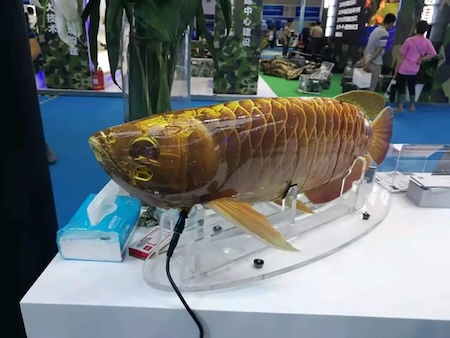Science Fiction
Dictionary
A B C D E F G H I J K L M N O P Q R S T U V W X Y Z
Ultra-Realistic Robotic Arowana Robo-Fish

Boya Gongdao has outdone itself with the amazingly realistic Arowana fish robot.

(Robo-Fish from Boya Gongdao)
The fish, created by the Boya Gongdao company, was placed in a giant transparent tank. Onlookers thought it was a real Arowana fish because it swam in the water and would hold its head up when there were barriers, then continued to swim again. The creators carefully studied the movement of the actual fish so that they could apply it to the robot.The company plans to sell Robo-fish to aquariums at home and abroad, hoping to save endangered fish by reducing marine life investments. On top of protecting marine creatures by keeping them in the ocean where they belong, aquariums can use the robot fish to interact with tourists. Besides, it also adds an exciting element of science and technology to the fish tank.
Robo-fish has several features which involve highly efficient sensors and receptors. In addition, it has a global vision control technology and a battery that lasts around 6-8 hours per charge...
(Robo-Fish from Boya Gongdao)
Regular Technovelgy readers are familiar with the robofish from Slow Life by Michael Swanwick; the linked page has a number of robot fish references and articles.
But given the extremely realistic appearance and behavior of the Boya Gongdao robo-fish, and its use in aquaria, I thought I'd reference the metal fish from Atom Drive (1956) by Charles Fontenay:
Deveet’s line tightened. He pulled in a streamlined, flapping object from which the light glistened wetly. “Good catch,” complimented Jonner. “That’s worth a full credit.”Deveet unhooked his catch and laid it on the bank beside him. It was a metal fish: live fish were unknown on Mars. They paid for the privilege of fishing for a certain time and any fish caught were “sold” back to the management at a fixed price, depending on size, to be put back into the lake.
As far as I know, the earliest use of the phrase "robot fish" is in At Kokomo Joe's, by Brooke Stauffer, published by Aboriginal Science Fiction in 1989.
Scroll down for more stories in the same category. (Story submitted 8/29/2024)
Follow this kind of news @Technovelgy.| Email | RSS | Blog It | Stumble | del.icio.us | Digg | Reddit |
Would
you like to contribute a story tip?
It's easy:
Get the URL of the story, and the related sf author, and add
it here.
Comment/Join discussion ( 0 )
Related News Stories - (" Robotics ")
Golf Ball Test Robot Wears Them Out
"The robot solemnly hit a ball against the wall, picked it up and teed it, hit it again, over and again...' - Frederik Poh, 1954.
PaXini Supersensitive Robot Fingers
'My fingers are not that sensitive...' - Ray Cummings, 1931.
Artificial Skin For Robots Is Coming Right Along
'... an elastic, tinted material that had all the feel and appearance of human flesh and epidermis.' - Harl Vincent (1934)
Robot Guard Dog On Duty
I might also be thinking of K-9 from Doctor Who.
Technovelgy (that's tech-novel-gee!) is devoted to the creative science inventions and ideas of sf authors. Look for the Invention Category that interests you, the Glossary, the Invention Timeline, or see what's New.
Science Fiction
Timeline
1600-1899
1900-1939
1940's 1950's
1960's 1970's
1980's 1990's
2000's 2010's
Current News
Golf Ball Test Robot Wears Them Out
"The robot solemnly hit a ball against the wall, picked it up and teed it, hit it again, over and again...'
Boring Company Vegas Loop Like Asimov Said
'There was a wall ahead... It was riddled with holes that were the mouths of tunnels.'
Rigid Metallic Clothing From Science Fiction To You
'...support the interior human structure against Jupiter’s pull.'
Is The Seattle Ultrasonics C-200 A Heinlein Vibroblade?
'It ain't a vibroblade. It's steel. Messy.'
Roborock Saros Z70 Is A Robot Vacuum With An Arm
'Anything larger than a BB shot it picked up and placed in a tray...'
A Beautiful Visualization Of Compact Food
'The German chemists have discovered how to supply the needed elements in compact, undiluted form...'
Bone-Building Drug Evenity Approved
'Compounds devised by the biochemists for the rapid building of bone...'
Secret Kill Switch Found In Yutong Buses
'The car faltered as the external command came to brake...'
Inmotion Electric Unicycle In Combat
'It is about the size and shape of a kitchen stool, gyro-stabilized...'
Grok Scores Best In Psychological Tests
'Try to find out how he ticks...'
PaXini Supersensitive Robot Fingers
'My fingers are not that sensitive...'
Congress Considers Automatic Emergency Braking, One Hundred Years Too Late
'The greatest problem of all was the elimination of the human element of braking together with its inevitable time lag.'
The Desert Ship Sailed In Imagination
'Across the ancient sea floor a dozen tall, blue-sailed Martian sand ships floated, like blue smoke.'
The Zapata Air Scooter Would Be Great In A Science Fiction Story
'Betty's slapdash style.'
Thermostabilized Wet Meat Product (NASA Prototype)
There are no orbiting Michelin stars. Yet.
Could Crystal Batteries Generate Power For Centuries?
'Power could be compressed thus into an inch-square cube of what looked like blue-white ice'
